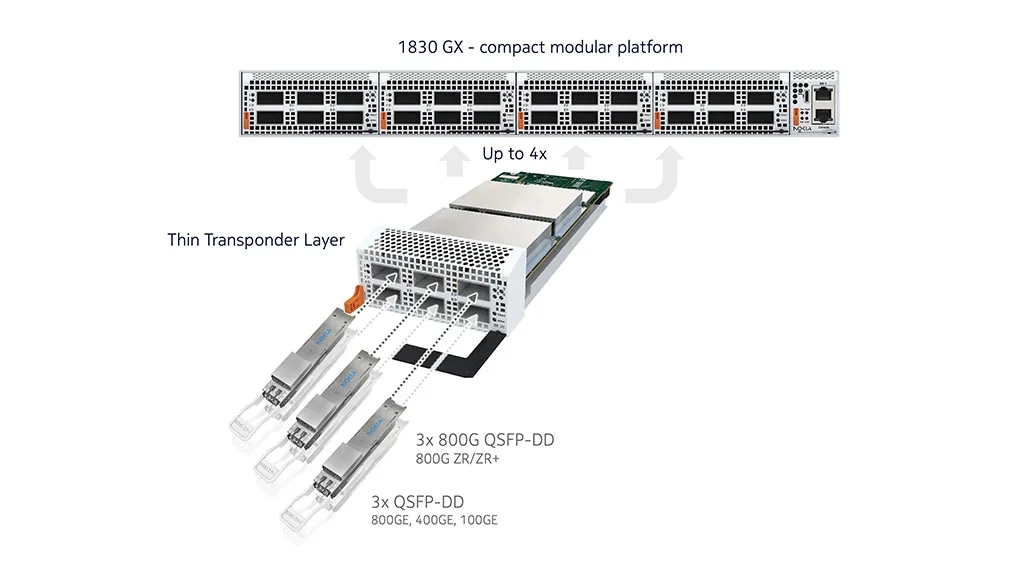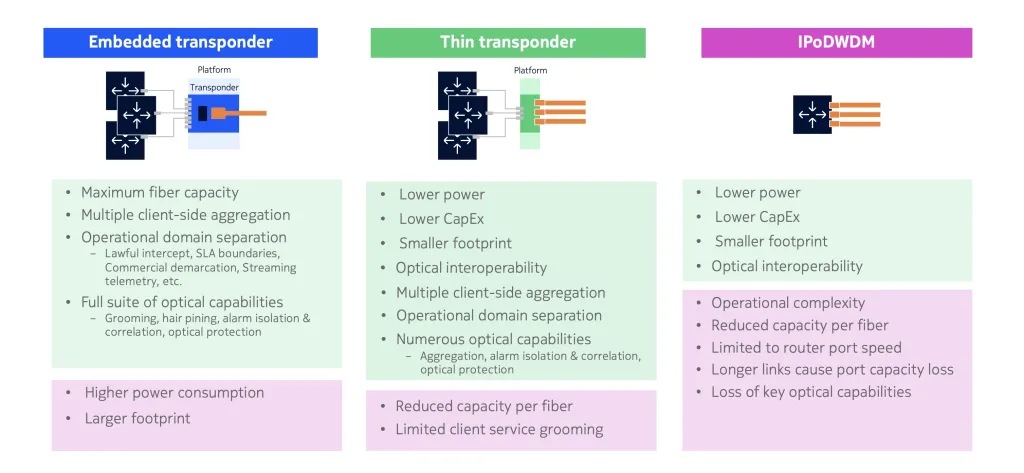Improving optical transport economics with thin transponders

In the ever-evolving world of optical networking, where capacity demands are skyrocketing and operational efficiency is paramount, a new class of technology is quietly reshaping the landscape: the thin transponder. It’s not just a buzzword—it’s a strategic innovation that’s poised to improve the way communications service providers (CSPs) utilize the next technology wave in their networks.
So, what exactly is a thin transponder, and why is it generating so much interest among network architects and operators? Let’s dive in.
The rise of the thin transponder
Optical transport networks have long relied on transponders housed in large, chassis-based systems. To build these high-performance optics, we traditionally needed larger space and adequate cooling.
These transport platforms, while robust, often come with high CAPEX and OPEX. With the past decade of technology evolution in coherent optics and advancements in digital signal processors (DSPs), we can today build 2.4 terabit per second (Tb/s) transponders that are the same size as a 100 gigabit per second (Gb/s) transponder from 20 years ago.
This technological evolution also enables us to build 800 Gb/s solutions in a pluggable QSFP-DD form factor that’s about the size of a human finger. As a result, the optical transport network system has become significantly more compact and modular. We have also significantly reduced power consumption, going from 4 W/Gb to 0.1 W/Gb within the last decade alone.
IP over DWDM (IPoDWDM) is now also emerging as a leaner alternative that integrates coherent pluggable optics directly into routers. However, IPoDWDM brings its own set of challenges, including limited vendor interoperability, complex management and constrained scalability.
Enter the thin transponder, a hybrid solution that combines the best of both worlds.

At its core, a thin transponder is a compact, power-efficient sled that integrates coherent pluggable optics with cost-effective transponder functionality, all within a compact modular transport platform. It’s designed to sit between traditional optical transport systems and direct IPoDWDM pluggable deployments, offering a sweet spot in terms of performance, cost, manageability and operational simplicity.
Why thin transponders matter
1. Low power per bit
Power efficiency is now a necessity. With data centers and metro networks under pressure to reduce their carbon footprint, thin transponders offer a compelling advantage. By leveraging the latest generation of coherent pluggables such as 800G ZR, these devices achieve industry-leading power/bit ratios, significantly lowering energy consumption per transmitted gigabit. With under 30 W for an 800 Gb/s coherent pluggable, we are at 0.0375 W/Gb today.
2. Low cost per bit
CAPEX and OPEX are always under scrutiny. Thin transponders reduce both by minimizing hardware footprint, simplifying deployment and enabling pay-as-you-grow scalability. Their modular nature allows CSPs to deploy only what they need, where and when they need it—without over-provisioning or locking into expensive chassis-based systems or large-capacity transponders like those that can support 2.4 terabits per sled, which might not be fully utilized.
3. Operational flexibility
Unlike the IPoDWDM deployment model, thin transponders maintain the disaggregation and openness of traditional optical networks. They can be deployed and managed independently of the IP layer and integrated seamlessly into existing transport architectures and management environments. The demarcation between IP and optical layers is typically beneficial and often needed because not all current routers support the latest coherent optical transceiver technology. Additionally, wholesale providers often don’t have access to IP devices and are not able to manage them.
Use cases: Where thin transponders shine
Thin transponders are particularly well-suited for:
-
Metro and regional networks, where space, power and cost constraints are most acute.
-
Data center interconnect (DCI), where they can offer high-capacity and low-power links between facilities while decoupling router and optical system evolution.
-
Enterprise and wholesale services, where they can enable flexible, service-level agreement (SLA)-driven connectivity without the need to overbuild while maintaining IP and optical domain separation.
A strategic and practical middle ground
Think of thin transponders as the Goldilocks of optical transport: not too heavy, not too light, but just right. They provide a strategic and practical middle ground between the robustness of traditional DWDM systems and the integration of IPoDWDM, without the trade-offs that typically come with either approach.

This positioning is especially valuable in today’s market, where operators are seeking to modernize their networks without undergoing disruptive overhauls. Thin transponders allow for incremental upgrades, multivendor interoperability, and future-proof scalability, all while keeping costs and complexity in check.
Looking ahead: The future of thin transponders
As coherent pluggable technology continues to evolve, pushing toward 800 Gb/s and beyond, the role of thin transponders will only become more critical. Their ability to provide high-performance transmission and great scalability at a low footprint, and to reduce total cost of ownership makes them a cornerstone of next-generation transport strategies.
As network functions become increasingly software-defined, thin transponders participate in and support programmable, automated and intent-based networking. Their modularity and openness make them ideal candidates for seamless integration into environments controlled by software-defined networking (SDN), where agility and visibility are paramount.
For network operators navigating the complex terrain between legacy infrastructure and future-ready architectures, thin transponders provide a clear path forward. They’re lean, they’re powerful, and they’re ready to transform the economics of optical networking.
To learn more about our flexible optical deployment options including thin transponders, check out the following on-demand webinar:
